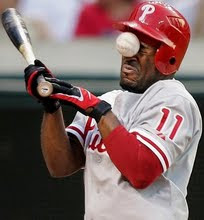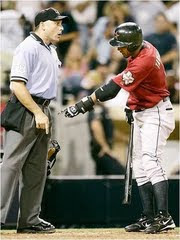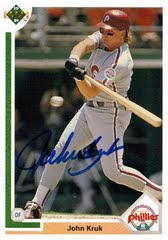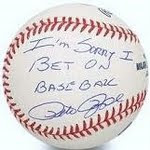Normally, I would would go to football sabermetrics to determine this answer. However, for wide receivers this does not help so much. There are two main statistical categories that are normally good: DVOA and DYAR. According to footballoutsiders.com:
The simple version: DYAR means a wide receiver with more total value. DVOA means a wide receiver with more value per play.
Last year Andre Johnson was #1 in DYAR, yet Devery Henderson of the Saints was #1 in DVOA. I don't think even Henderson's mom would think her son is better than Andre Johnson. Last year, the top five wide outs in terms of DYAR were:
1) Andre Johnson (Texans)
2) Larry Fitzgerald (Cardinals)
3) Roddy White (Falcons)
4) Vincent Jackson (Chargers)
5) Steve Smith (Panthers)
Pretty elite list, no? Now let's take a look at top wide outs by DVOA
1) Devery Henderson (Saints)
2) Vincent Jackson (Chargers)
3) Anthony Gonzalez (Colts)
4) Steve Smith (Panthers)
5) Roddy White (Falcons)
At first glance, you would probably say that DYAR is the better metric for judging wide outs, especially considering the names consistently, year after year, atop of DYAR lists versus those a top the DVOA.
But wait a minute, that's not quite fair to those on the DVOA list; the main reason the guys on the DVOA list don't really top the DYAR list is because they don't get thrown to. Using that logic, Craig Biggio is a guaranteed Hall of Famer just because he got so many ABs that he was able to join the 3,000 hits club. Andre Johnson caught as many passes (115) than Henderson had balls throw to him (56). If Henderson had had 171 passes thrown his way like Johnson did, he would have easily have been the best receivers last year. In fact, here's what Henderson's numbers would have been if that had happened:
171 passes, 97 receptions, 2,417 yards, 9 TDs, 24.8 YPR
Here's what Andre Johnson did do:
171 passes, 115 receptions, 1,575 yards, 8 TDs, 13.1 YPR
The reason Henderson's numbers looked so good and the reason he was #1 in DVOA, because he had a league best 24.8 Yards Per Reception. Judging wide outs using a baseball sabermetric mind, we WOULD say that Devery Henderson was better than Andre Johnson, just Johnson had more passes thrown his way (ABs). But the problem, is that judging a wide out by his average is not really the way to go. It's perfect for a RB, but not so much for a wide receiver. Take this scenario:
Player A: 10 catches, 100 yards, 1 TD, 10 YPR
Player B: 2 catches, 100 yards, 1 TD, 50 YPR
By average terms, we would say that Player B was better because he was able to do more with less and his five times greater yards per reception. But I don't believe that true in real life. I would actually argue that Player A was better because he (probably) got more first downs for his team and was consistently available throughout the entire game, versus Player B, who probably just one amazing play. Both look good for fantasy football, but I would say Player A was better in the real game. So while a wide out like Andre Johnson may get more passes and catches, that actually does make him better! Receptions are analogous to ABs in baseball, but in baseball, you don't FORCE ABs, their automatic. Not true in football. A wide receiver had to FORCE himself to get open and the consistently make catches.
That, I believe, leads a nice transition into my last metric to judge a wide out: catch rate. Here's how footballoutsiders.com defines catch rate:
Catch Rate represents the percentage of passes to this receiver completed. This is a reference to incomplete passes, not dropped passes: dropped passes are not specified in publicly available play-by-play, and unfortunately we cannot yet correct for this.
Unfortunately catch rate is not perfect yet, but it's pretty damn close. It essentially states that how well does a receiver do when the ball is thrown to him. It doesn't account for how many passes a receiver was thrown, just individually, how well does a player do when the ball is throw the receiver's way. And isn't that really what a wide out's job is: to catch passes thrown his way. Last year, there were only ten receivers who topped 70% in catch rate with a minimum of 50 passes thrown his way:
1) Ike Hillard (Bucs): 81%
2) Wes Welker (Patriots): 75%
3) Greg Jennings (Packers): 72%
3) Devone Bess (Dolphins): 72%
3) Anthony Gonzolaz (Colts): 72%
6) Anquan Boldin (Cardinals): 71%
6) Antonio Bryant (Bucs): 71%
6) Josh Reed (Bills): 71%
6) Eddie Royal (Broncos): 71%
10) Steve Smith (Giants): 70%
Sure, this list doesn't look at flashy or "good" as the DYAR list, but I think this is the better metric than both DYAR and DVOA. Sure, the vast majority of this list consists of guys that you don't think are "good", but that's because they don't get thrown to a lot. Sure, you can make the argument that because these guys weren't good they couldn't get open and thus the limited time they did get open they were able to catch what was thrown. But the fact that these guys couldn't get open makes them not good. And I don't know about that. It could be true, but I think that logic understates just how well these guys did when their number was called.
So back to our original question: how do you measure a wide receiver? Well I don't think you can use just one measure. I think it's just fine to look at the "traditional" and fantasy football numbers just fine. Despite what I wrote in this article, you'd be hard pressed to say that Devery Henderson and Ike Hillard are better than Andre Johnson, Larry Fitzgerald, and Randy Moss. Those guys put up a ton of yards and TDs. Sure they may not get it as efficiently as guys like Henderson or Anthony Gonzalez, but they sure as hell produce.
But that's not to say you shouldn't look beneath the surface either. Looking at DVOA, DYAR, and catch rate is extremely useful. But I think for wide receivers, it's mainly a secondary source to the primary of catches, yards, and TDs.







4 comments:
I have an idea. Just like we measure QBs by yards per attempt, we can measure a receiver by yards per attempt. This would encompass both efficacy(yards) and efficiency(completion %).
Thats why they call me TBO
I like TBO idea. Though some things can't be measured very well, especially by stats. It is hard to measure a wide receiver because there are so many factors from how many attempts they get, the accuracy of the quarterback, and the players around them who effect if they can make a play.
yeah but that gets us to the same problem as AVG. I'm sure Devery Henderson would top that list too and would be higher than guys like Larry Fitzgerald and Andre Johnson.
There's something to be said for passes thrown to and passes caught just because receivers aren't guaranteed to get thrown to the way RBs are guaranteed carries or players guaranteed ABs.
I think the best way to look at receivers is still the traditional way but to look at the "other" stats to see which guys do great things with their limited opportunities
A problem with catch rate is that it treats receivers as equals in terms of the difficulty of the patterns they are running. So, in the case of the Patriots, Welker has a higher catch rate than Moss, but Welker catches most of his passes within 5 yards of scrimmage, whereas Moss is working downfield. TBO's idea of receiving-yards-per-attempt in this scenario at least compensates because the downfield receptions of Moss would gain more yards per reception.
Post a Comment